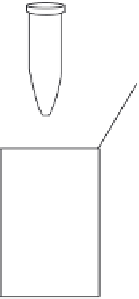Biology Reference
In-Depth Information
150
C; however, a brief exposure (
1 min) to a heating element followed by 10-
20 min at room temperature should be adequate for curing before moving on to
shaping of the tip. The Sylgard is most e
<
ective when it is applied thickly, but
prevents giga-ohm seal formation if it gets on the tip. Our method of applying
Sylgard is illustrated in
Fig. 1
. We use gravity by mounting the pipette vertically
V
A
C
E
B
D
F
Fig. 1
Application of Sylgard. Sylgard (Corning 184), a heat-cured polymer, is applied to patch
pipettes after pulling but before polishing to reduce the capacitance between the glass walls and the bath.
(A) Sylgard is stored in small 1-ml plastic tubes in the freezer until it is ready for use. Room temperature
Sylgard is applied using a 25-gauge hypodermic needle that is bent for ease of application. The needle
hub is a
xed to a plastic tube for ease of handling. (B) The pipettes are placed into a hand-made holder
that holds the pipette upright and allows it to be positioned easily so that the heating element made of
tungsten wire surrounds the tip. (C) The pipette is positioned so that the area from the first narrowing of
the glass to the tip is placed above the heating element. (D) Sylgard is applied in consecutive rings or
''donuts'' starting at the area where the glass first narrows. This lower ring helps protect against noise if
your bath height changes between perfusions. (E) Between applications of consecutive rings, apply heat
to cure each ring. Remember that heat goes up, so the hottest area near the heating wire is above it. (F)
The final ring should also coat the taper of the pipette and can be placed as close as 50-100 nm from the
tip. Be careful not to get Sylgard on the tip or on the heating element!
Y
























































